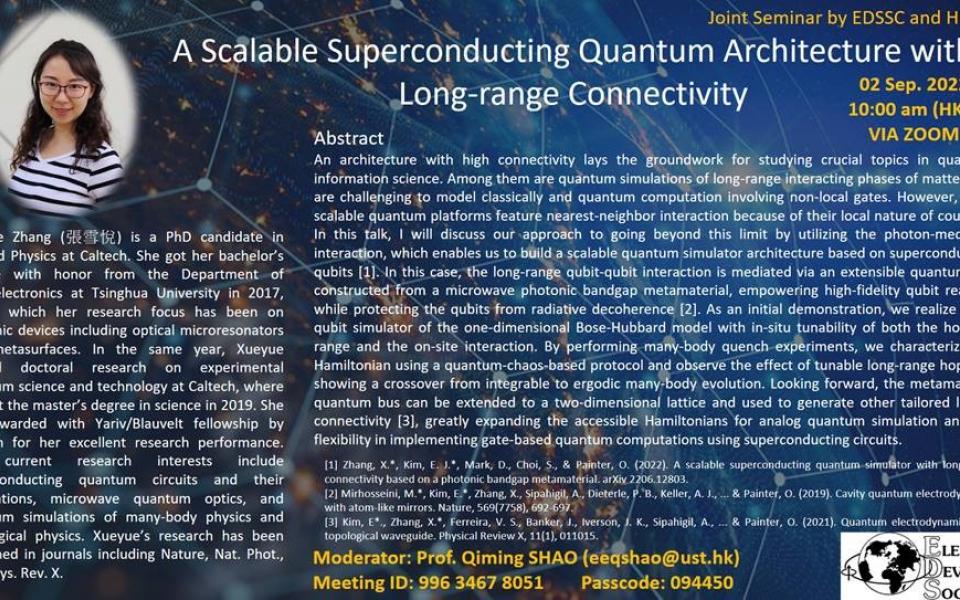Joint seminar by HKUST ECE department and IEEE HK ED/SSC Joint Chapter - A Scalable Superconducting Quantum Architecture with Long-range Connectivity
Supporting the below United Nations Sustainable Development Goals:支持以下聯合國可持續發展目標:支持以下联合国可持续发展目标:
Abstract
An architecture with high connectivity lays the groundwork for studying crucial topics in quantum information science. Among them are quantum simulations of long-range interacting phases of matter that are challenging to model classically and quantum computation involving non-local gates. However, most scalable quantum platforms feature nearest-neighbor interaction because of their local nature of coupling. In this talk, I will discuss our approach to going beyond this limit by utilizing the photon-mediated interaction, which enables us to build a scalable quantum simulator architecture based on superconducting qubits [1]. In this case, the long-range qubit-qubit interaction is mediated via an extensible quantum bus constructed from a microwave photonic bandgap metamaterial, empowering high-fidelity qubit readout while protecting the qubits from radiative decoherence [2]. As an initial demonstration, we realize a 10-qubit simulator of the one-dimensional Bose-Hubbard model with in-situ tunability of both the hopping range and the on-site interaction. By performing many-body quench experiments, we characterize the Hamiltonian using a quantum-chaos-based protocol and observe the effect of tunable long-range hopping, showing a crossover from integrable to ergodic many-body evolution. Looking forward, the metamaterial quantum bus can be extended to a two-dimensional lattice and used to generate other tailored lattice connectivity [3], greatly expanding the accessible Hamiltonians for analog quantum simulation and the flexibility in implementing gate-based quantum computations using superconducting circuits.
[1] Zhang, X.*, Kim, E. J.*, Mark, D., Choi, S., & Painter, O. (2022). A scalable superconducting quantum simulator with long-range connectivity based on a photonic bandgap metamaterial. arXiv 2206.12803.
[2] Mirhosseini, M.*, Kim, E.*, Zhang, X., Sipahigil, A., Dieterle, P. B., Keller, A. J., ... & Painter, O. (2019). Cavity quantum electrodynamics with atom-like mirrors. Nature, 569(7758), 692-697.
[3] Kim, E*., Zhang, X.*, Ferreira, V. S., Banker, J., Iverson, J. K., Sipahigil, A., ... & Painter, O. (2021). Quantum electrodynamics in a topological waveguide. Physical Review X, 11(1), 011015.
Xueyue Zhang (張雪悅) is a PhD candidate in Applied Physics at Caltech. She got her bachelor’s degree with honor from the Department of Microelectronics at Tsinghua University in 2017, before which her research focus has been on photonic devices including optical microresonators and metasurfaces. In the same year, Xueyue started doctoral research on experimental quantum science and technology at Caltech, where she got the master’s degree in science in 2019. She was awarded with Yariv/Blauvelt fellowship by Caltech for her excellent research performance. Her current research interests include superconducting quantum circuits and their applications, microwave quantum optics, and quantum simulations of many-body physics and topological physics. Xueyue’s research has been published in journals including Nature, Nat. Phot., and Phys. Rev. X.
